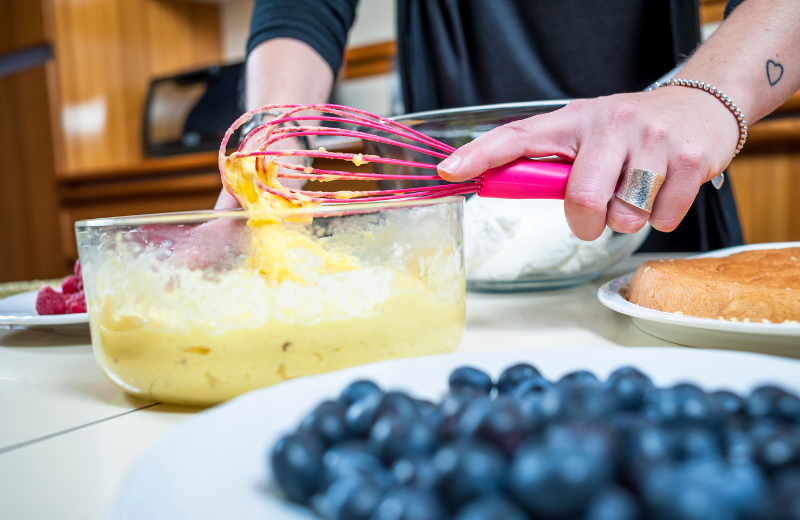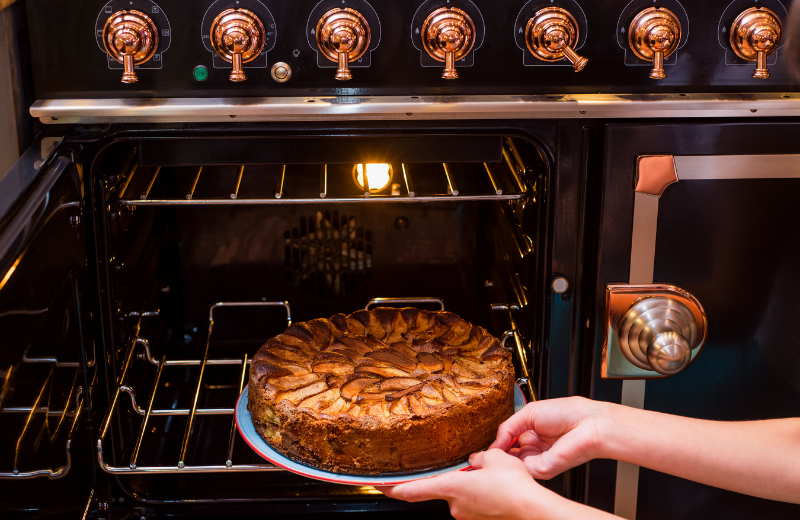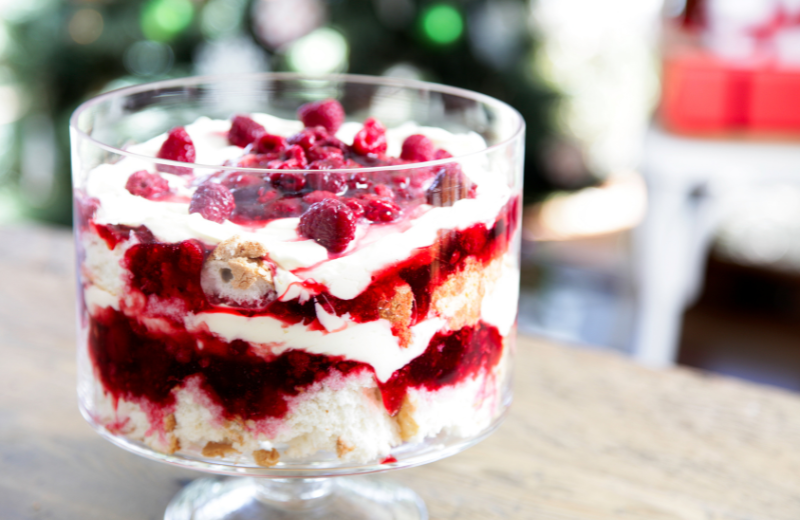There’s nothing more disappointing than peering into the oven, full of anticipation, only to find your cake hasn’t risen as it should. You followed the recipe, set the right temperature, and yet—there it is—flat, dense, and far from the light, fluffy sponge you imagined.
Baking is as much a science as it is an art, and even the smallest misstep can leave you with a flat cake. The good news is that once you understand what makes a cake rise, you’ll be far better equipped to avoid a flat cake in the future. Let’s explore the common reasons your cake isn’t rising and, more importantly, how to fix it.
Jump to:
Recommended for you!
Best SellersWhat Makes a Cake Rise?
To avoid a flat cake, it’s helpful to understand what causes a cake to rise in the first place. The rise of a cake depends on a delicate balance of ingredients, temperature, and technique.
Leavening agents such as baking powder, baking soda, or beaten eggs create air bubbles in the batter. When exposed to heat, these bubbles expand, causing the cake to rise. If anything disrupts this process, you might be left with a flat cake.
Common Reasons Why Your Cake Isn't Rising

When your cake refuses to rise, it’s rarely down to bad luck. There are a few common baking pitfalls that can leave you scratching your head and asking, “Why aren’t my cakes rising?” The good news is that each of these issues has a simple solution once you know what to look out for.
1. Expired or Incorrect Leavening Agents
One of the most common reasons for a cake not rising is the use of old or incorrect leavening agents. Baking powder and baking soda lose their effectiveness over time. If they’re past their best, they simply won’t give your cake the lift it needs.
How to Fix It: Always check the expiry date before you start baking. Even if it’s within date but has been open for a while, it’s worth testing. To check baking powder, stir a teaspoon into warm water—if it fizzes enthusiastically, it’s good to go. For baking soda, mix a small amount with vinegar; if it bubbles, it’s still active. Using fresh, properly stored leavening agents is key to ensuring a good rise.
2. Overmixing or Undermixing the Batter
If your cake comes out flat, your mixing technique could be at fault. Overmixing knocks out the precious air bubbles needed for rising, resulting in a dense, flat cake. On the other hand, undermixing can leave pockets of unmixed ingredients, preventing an even rise and proper texture.
How to Fix It: Mix just until everything is combined and smooth. When creaming butter and sugar, aim for a light and fluffy texture, as this helps trap air. Once you add flour, switch to a gentle folding motion to avoid losing that air. Remember, in baking, less is often more when it comes to mixing.
3. Incorrect Oven Temperature
A frequent culprit behind cakes not rising is baking at the wrong temperature. If your oven runs too hot, the cake may puff up quickly and collapse before setting. If it’s too cool, the leavening agents won’t activate properly, resulting in little to no rise.
How to Fix It: Oven dials can be misleading, so investing in an oven thermometer is a smart move for any baker. This small tool ensures you're baking at the exact temperature required. For fan ovens, always reduce the suggested temperature by around 20°C unless the recipe accounts for it. Consistent heat is crucial for a steady, even rise.
4. Opening the Oven Door Too Soon
It’s natural to want to check on your baking progress, but opening the oven door too early is a common reason why your cake sinks after rising. The sudden rush of cooler air can cause the delicate structure of your cake to collapse before it has had a chance to set.
How to Fix It: Patience is key. Avoid opening the oven door until your cake is nearly done; ideally after 75% of the baking time has passed. If you need to check, do it quickly and gently close the door to maintain as much heat as possible.
5. Incorrect Measurements
Baking is a precise science, and inaccurate measurements can result in a flat cake. Too much flour can make your batter too heavy, while too little leavening agent means there’s not enough power to lift the cake.
How to Fix It: Always measure ingredients carefully. Digital scales offer far greater accuracy than cups or spoons. If you're using volume measurements, spoon the flour into the cup and level it off with a knife. Never scoop directly from the bag, as this packs in more flour than needed. A small measuring mistake can make a big difference in whether your cake rises properly.
6. Using the Wrong Tin Size
To make sure a cake rises evenly, consider whether you're using the right tin. A tin that’s too large will spread the batter thinly, causing it to bake flat rather than rise, while a tin that’s too small can cause the cake to overflow or rise unevenly.
How to Fix It: Stick to the recommended tin size in your recipe for best results. If you only have a different size available, adjust the quantity of batter or baking time accordingly. As a general rule, the batter should fill the tin about halfway to two-thirds full to allow space for rising without spilling over.
Why Does My Cake Go Flat After Baking?

Even if your cake rises beautifully in the oven, it might still deflate once it's out. This can be due to underbaking, meaning the structure hasn’t set properly. Discover our guide on what to do when your cake isn’t cooked in the middle.
To avoid a flat cake, check for doneness by inserting a skewer into the centre; it should come out clean or with a few crumbs attached. If the skewer has wet mixture on it, return your cake to the oven and check it every few minutes.
What to Do If My Cake Didn't Rise?

If you’re left with a cake that didn’t rise, then don’t worry! While it might not look picture-perfect, a flat cake can still be put to delicious use. Here are some creative ways to repurpose it:
- Make a trifle: Layer pieces of the cake with whipped cream, custard, and fruit for a quick and tasty dessert.
- Create cake pops: Crumble the cake, mix with a little frosting, shape into balls, and dip in melted chocolate.
- Build an ice cream cake: Use the flat sponge as a base for an ice cream dessert, layering with your favourite flavours.
- Turn it into a cheesecake base: Replace biscuits with cake crumbs for a soft, sweet cheesecake bottom.
- Serve with custard or sauce: Warm slices of flat cake served with custard, cream, or a fruit sauce still make a lovely treat.
And yes, you can eat a cake that has sunk in the middle. It’s just as safe and tasty—it might just need a little creative presentation!
Recommended for you!
Best SellersHow to Make Sure Your Cake Rises in Future
A nicely risen cake starts with a few simple but important steps that are easy to follow. Keep these tips in mind to achieve light and fluffy bakes every time.
- Check your leavening agents are fresh – Always test baking powder or baking soda if you're unsure of their effectiveness.
- Measure ingredients accurately – Use digital scales or proper measuring techniques to avoid heavy or unbalanced batter.
- Mix the batter correctly – Combine ingredients gently to keep enough air in the mixture without overworking it.
- Use the right tin size – Stick to the recommended tin to give your cake the best chance to rise evenly.
- Preheat your oven and bake at the correct temperature – Use an oven thermometer to ensure consistent heat, especially in fan ovens.
- Avoid opening the oven door too early – Keep the door closed until most of the baking time has passed to prevent sudden temperature drops.
- Follow the recipe closely – Small changes can impact how your cake rises, so stick to trusted instructions for reliable results.
Study Our Cake Baking and Decorating Diploma for £29
Once you understand what makes a cake rise, you’ll feel more confident tweaking recipes and spotting where things went wrong.
If you’re passionate about baking or want to develop your skills further, the Cake Baking and Decorating Diploma Course from Centre of Excellence is a fantastic next step. It’s designed to suit all levels – whether you’re just starting or looking to master advanced techniques. And right now, you can enrol for just £29.













